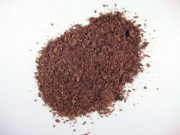Difference between revisions of "Peat"
Jump to navigation
Jump to search
(username removed) |
m (Text replace - "== Authority ==" to "== Sources Checked for Data in Record ==") |
||
| Line 16: | Line 16: | ||
|} | |} | ||
| − | == | + | == Sources Checked for Data in Record == |
* G.S.Brady, ''Materials Handbook'', McGraw-Hill Book Co., New York, 1971 Comment: p. 584 | * G.S.Brady, ''Materials Handbook'', McGraw-Hill Book Co., New York, 1971 Comment: p. 584 | ||
Revision as of 14:43, 1 May 2016
Description
A soft, brown mass of semicarbonized, partially decomposed residue from plants. Peat is found in water-saturated environments, such as a bog. When dried, the light, spongy material is used as an organic fuel. Dried peat burns with a smoky flame and a characteristic odor.
See also lignite.
Synonyms and Related Terms
turba (Esp.); tourbe (Fr.); turfa (Port.); Torf (Deut.); turf (Ned.)
| Density | 0.84 |
|---|
Sources Checked for Data in Record
- G.S.Brady, Materials Handbook, McGraw-Hill Book Co., New York, 1971 Comment: p. 584
- Encyclopedia Britannica, http://www.britannica.com Comment: Peat. Encyclopædia Britannica. Retrieved July 1, 2003, from Encyclopædia Britannica Premium Service.
- Website address 1 Comment: Material Explorer at www.materialexplorer.com (Accessed Oct 27, 2005)
- CRC Handbook of Chemistry and Physics, Robert Weast (ed.), CRC Press, Boca Raton, Florida, v. 61, 1980 Comment: density=0.84
- Art and Architecture Thesaurus Online, http://www.getty.edu/research/tools/vocabulary/aat/, J. Paul Getty Trust, Los Angeles, 2000
